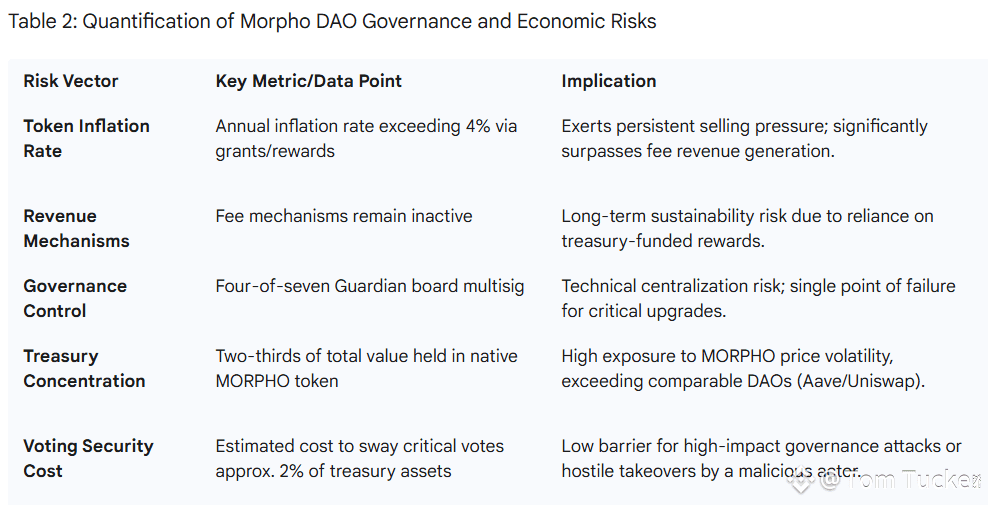Tokenomics and the Public Good Dilemma: Navigating Inflation, Governance, and the MORPHO Treasury
While Morpho’s technical architecture is pioneering and highly efficient, a critical analysis of its governance and tokenomics reveals structural risks that challenge the protocol’s long-term sustainability and decentralization objectives.

6.1 The Inflationary Burden and Inactive Revenue
Economic analysis indicates a persistent imbalance in the Morpho DAO’s financial structure. The DAO is currently issuing its native MORPHO token at a rate that outpaces market demand, creating continuous economic pressure. Specifically, the distribution of MORPHO tokens through various grant and reward programs results in a combined annual inflation rate exceeding 4% of the total supply.
This substantial inflationary rate significantly surpasses the protocol’s internally generated fee revenues, which currently remain inactive. This reliance on treasury-funded rewards, rather than platform-generated revenue, leads to persistent selling pressure on the MORPHO token supply. Furthermore, there are identified operational inefficiencies, including overlapping grants for application development and potentially redundant security audits, which suggest optimization is possible. To counteract this dynamic, proposals to introduce structural demand drivers—such as vote-escrow staking mechanisms and mandatory deposits for governance proposals—are under consideration but have not yet been implemented.
6.2 Centralization Risks in Governance
The protocol operates under a decentralized framework, using the MORPHO token for weighted voting rights over protocol upgrades, treasury management, and risk parameters. However, crucial control points remain centralized. A four-of-seven Guardian board retains control over core protocol upgrades, representing a technical single point of failure inherent in multisignature control structures.
Governance participation among the broader electorate has been identified as negligent, with quorum levels often barely meeting minimum thresholds. A substantial portion of the token holders abstains from voting, highlighting principal-agent risks. This low participation has tangible security consequences; oracle vulnerabilities have already resulted in security incidents, yet half of the electorate abstained from relevant governance votes. The concentration of power is further evidenced by the low barrier for governance manipulation: estimates suggest a single actor with a few million dollars could secure enough voting power to push through critical changes, with the estimated cost to sway a critical vote being only approximately 2% of the treasury assets.
The legal structure further complicates community participation; Morpho is registered as a French non-profit association, which lacks the formal limited liability framework necessary to safeguard participants against potential legal exposure.
6.3 Treasury Concentration and Structural Risk
A third major economic concern is the composition of the DAO’s treasury. The Morpho treasury retains a highly concentrated risk profile, holding two-thirds of its total value in its native MORPHO token. This concentration exposes the treasury heavily to the price volatility of its own asset. Benchmarking against comparable decentralized autonomous organizations (DAOs), such as Aave and Uniswap, reveals that Morpho maintains a higher level of internal treasury concentration, escalating the potential for significant capital impairment during market downturns. This structural risk requires mitigation through asset diversification and the implementation of mechanisms that create external demand for the MORPHO token, moving away from reliance on perpetual inflation.

Beyond the Pool: Intent-Based Lending and Morpho's 20-Year Vision for Financial Architecture
Morpho’s architectural evolution is continuous, and the roadmap points toward a profound, fundamental shift from pool-based or even hybrid P2P models to a sophisticated, intent-based trading infrastructure. This next iteration, Morpho V2, repositions the protocol as a designer of complex financial markets, capable of handling products that extend far beyond simple collateralized lending.
7.1 The Shift to Intent-Based Lending (V2)
The future of lending, according to Morpho’s founders, looks less like a pooled system and more like advanced trading infrastructure. Morpho V2 is centered on "intent-based lending," a paradigm shift away from mechanical interest rate formulas governed by utilization ratios.
In the intent-based model, users (lenders and borrowers) express specific needs or "intents," which are comprehensive declarations of desired terms—including specific fixed rates, duration, collateral specifications, and liquidation requirements. The system then uses order book mechanics to match these intents, facilitating customized, non-fungible credit agreements. This is the zero-to-one change that unlocks a new realm of financial primitives.
This architectural advancement enables the efficient creation of products that are difficult to manage within shared liquidity pools, such as standardized fixed-rate bonds and, eventually, complex under-collateralized lending based on verifiable trust commitments. This transition elevates Morpho from being merely an optimization layer (V0) or a simple primitive composer (V1) to becoming a true market designer, capable of modeling sophisticated financial agreements that mimic tailor-made derivatives and bond markets found in traditional finance.
7.2 Fixed Rates, Cross-Chain Liquidity, and Composability
A key limitation of modern DeFi is fragmentation—liquidity is siloed across protocols and chains. Morpho V2 addresses this by aiming for the unification of cross-chain liquidity. The system will be designed so that a borrower’s intent on one chain can be matched instantly by a lender’s supply intent across multiple different chains, maximizing capital reach and efficiency. This unified approach strengthens Morpho’s ecosystem by making it the most efficient destination for credit, further reinforcing its status as foundational architecture.
The emphasis on fixed-rate bonds is particularly strategic. Institutional and corporate users require rate certainty for financial planning and risk management, a feature unreliable in variable-rate pooled models. Fixed rates move DeFi lending away from pure speculation and toward real-world use cases, ensuring that the protocol can accommodate regulated financial entities with stringent operational needs. The long-term vision extends even further, predicting that everything in finance will ultimately become "tokenized trust commitments," allowing for the development of sophisticated credit score-based, under-collateralized lending markets over the next two decades.
7.3 The Philosophical Underpinning: Refinement and Resilience
Morpho’s success is rooted in its philosophical grounding—a commitment to careful engineering, thoughtful design, and quiet, persistent progress. The protocol’s restraint, focus, and precision distinguish it in a market often dominated by hype and fleeting speculation.
Morpho’s story is defined by its ability to achieve efficiency without introducing proportional risk, complexity, or fragmentation. By relentlessly refining the credit primitive, the protocol creates a resilient foundation for financial coordination, positioning itself as the infrastructure of the next financial era. When the typical market noise settles, the fundamental machinery of efficient lending built by Morpho will remain, delivering the simplicity, fairness, and logic that decentralized finance originally promised.
#Morpho @Morpho Labs 🦋 $MORPHO

